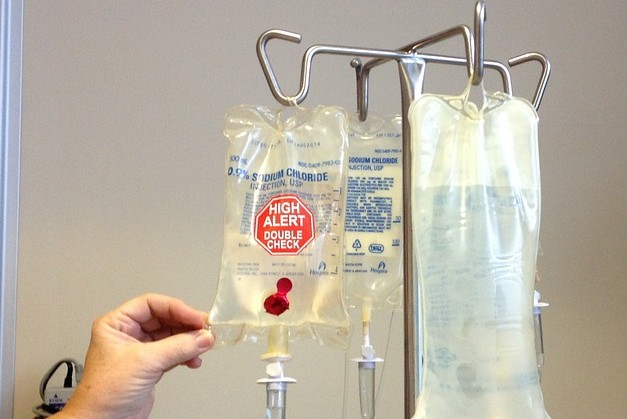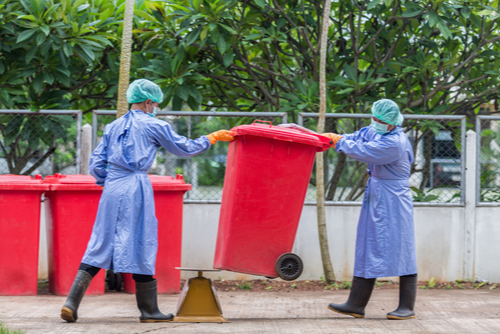Medical Waste Removal Quality: Elevating Safety Specifications in Your Center
Wiki Article
The Significance of Correct Clinical Garbage Disposal: A Guide for Medical Care Facilities
Proper medical garbage disposal is an essential element of healthcare center administration, making certain the security and well-being of individuals, personnel, and the environment. From recognizing the different groups of medical waste to adhering to regulative requirements, health care centers need to take on efficient waste partition methods and pick ideal disposal approaches. However, the relevance of proper clinical garbage disposal surpasses simple conformity; it is an obligation that needs ongoing training and education and learning for team. In this guide, we will certainly explore the various facets of medical garbage disposal and highlight the vital actions that medical care facilities ought to take. By carrying out these techniques, health care centers can mitigate risks, safeguard public health and wellness, and add to a cleaner, more secure environment.Comprehending Medical Waste Categories
Understanding medical waste categories is essential for proper disposal in healthcare centers. Medical waste is a wide term that encompasses various sorts of waste generated in healthcare setups, such as laboratories, facilities, and medical facilities. Classifying medical waste helps make certain that it is managed, stored, and disposed of securely and according to relevant guidelines.There are several classifications of medical waste that health care facilities require to be familiar with. These categories include transmittable waste, sharps waste, pharmaceutical waste, chemical waste, and contaminated waste (medical waste disposal services with WasteX). Each classification has details characteristics and calls for different disposal methods to reduce the danger of damage to healthcare employees, patients, and the setting
Infectious waste, for instance, refers to lose polluted with potentially transmittable products, such as blood, body fluids, and cells. Drug waste consists of expired or extra medicines, while chemical waste consists of dangerous chemicals used in clinical procedures.
Compliance With Regulatory Needs
Medical care centers need to make sure conformity with regulatory needs for appropriate medical garbage disposal. Regulatory bodies, such as the Epa (EPA) and the Occupational Safety And Security and Health And Wellness Administration (OSHA), have actually established laws and guidelines to guard public health and wellness and the atmosphere. These guidelines describe the correct handling, storage, transport, and disposal of medical waste.Conformity with regulatory needs is important for medical care facilities to stay clear of legal fines, reputational damage, and prospective injury to human health and wellness and the setting. Failure to adhere to these regulations can lead to fines, claims, and also the suspension or cancellation of running licenses.
To guarantee conformity, healthcare centers ought to develop comprehensive waste administration programs that consist of personnel training, correct waste segregation, and the use of ideal containers and labels. Routine audits and examinations should also be conducted to determine any kind of non-compliance concerns and address them immediately.
It is essential for health care centers to keep up to date with changes in policies and update their waste administration methods appropriately. This can be accomplished by proactively monitoring updates from regulatory bodies and taking part in training programs and workshops.
Carrying Out Efficient Waste Partition Practices
To make sure correct medical waste disposal, healthcare facilities must execute efficient waste segregation methods. Waste segregation is a vital action in the general waste administration process, as it helps reduce the danger of infection, avoids cross-contamination, and guarantees the risk-free disposal of different kinds of waste. Reliable waste partition methods include separating medical waste right into various classifications based on its qualities and potential hazards.One usual technique is the partition of sharps waste, such as needles and scalpels, from other sorts of clinical waste. Sharps waste need to be positioned in puncture-resistant containers to prevent injuries and possible infections. In addition, harmful waste, such as chemicals and pharmaceuticals, need to be divided from general clinical waste to stop environmental contamination.
Correct labeling and color-coding of waste containers are crucial for reliable waste segregation. Noticeable and clear tags ought to be positioned on each container to suggest the type of waste it contains and any kind of special delivery requirements - medical waste disposal services with WasteX. Furthermore, color-coding can be made use of to distinguish in between various waste categories, making it much easier for healthcare staff to recognize and dispose of waste appropriately
Normal training and education for medical care team is essential for the effective execution of waste segregation techniques. Team member ought to be informed on the different waste classifications, correct partition strategies, and the significance of complying with waste Learn More Here monitoring protocols. This will help guarantee conformity and uniformity in waste partition techniques throughout the facility.
Choosing Appropriate Disposal Approaches
Correct choice of proper disposal approaches is important in making sure the ecologically liable and safe monitoring of medical waste in healthcare facilities. Health care centers generate a selection of medical waste, consisting of sharps, transmittable waste, pharmaceutical waste, and chemical waste - medical waste removal service. Each type of waste calls for details disposal approaches to reduce the danger of contamination, injury, and ecological damageOne usual disposal method for clinical waste is incineration. Incineration entails the regulated burning of waste at high temperatures. This method works in destroying pathogens and lowering the volume of waste. It can release damaging toxins into the air if not appropriately regulated.

Chemical disinfection is one more method used for sure kinds of clinical waste, such as pharmaceutical waste. This approach uses chemicals to neutralize or ruin impurities. Nonetheless, it is necessary to select chemicals that are ecologically pleasant and risk-free.
In some instances, land fill disposal may appropriate for non-hazardous medical waste (medical waste disposal services with WasteX). Nonetheless, correct partition and packaging are important to stop leakage or contamination.
Ultimately, healthcare centers need to thoroughly examine the attributes of their medical waste and pick proper disposal techniques that prioritize safety, environmental defense, and regulatory conformity. Routine training and monitoring are crucial to make certain that health care staff adheres to appropriate disposal methods.
why not look here

Training and Educating Team on Appropriate Disposal Treatments
Personnel education and learning and training play a vital role in making certain the proper disposal of clinical waste in healthcare centers. It is essential that all personnel, including medical professionals, nurses, professionals, and support personnel, obtain detailed training on proper disposal procedures. This training needs to cover the different sorts of clinical waste, their potential dangers, and the appropriate techniques for taking care of, segregating, and taking care of them.One of the main objectives of team education and training is to make sure that all medical care professionals understand the value of correct disposal procedures and the potential repercussions of incorrect waste monitoring. They require to be aware of the risks connected with clinical waste, such as the transmission of infections and the contamination of the environment. medical waste removal. By understanding these dangers, personnel will certainly be extra determined to follow proper disposal protocols and take the required safety measures to shield themselves, their colleagues, and the neighborhood
Training ought to likewise cover using personal safety equipment (PPE) and the appropriate methods for dealing with medical waste. Personnel members should be educated on how to recognize and set apart various types of waste, such as sharps, contagious waste, and dangerous chemicals. They ought to also be educated on the correct usage of waste containers, such as sharps containers and biohazard bags, in addition to the significance of labeling and sealing these containers appropriately.
In addition, team education and training ought to consist of normal updates and correspondence course to ensure that medical care specialists stay informed concerning the most recent guidelines and finest methods in medical garbage disposal. This continuous education is crucial to keep a high level of recognition and compliance among personnel members.
Verdict
In final thought, proper clinical waste disposal is of utmost importance for medical care facilities. Recognizing the different groups of clinical waste and conforming with regulative needs ensures the safety and wellness of both medical care workers and the basic public.From recognizing the different groups of medical waste to abiding with regulatory demands, medical care facilities need to adopt effective waste partition techniques and choose proper disposal approaches. These categories include transmittable waste, sharps waste, pharmaceutical waste, chemical waste, and contaminated waste.To make sure appropriate clinical waste disposal, healthcare facilities need to apply effective waste segregation methods. Waste partition is a critical step in the overall waste administration procedure, as it aids decrease the risk of infection, avoids cross-contamination, and makes sure the secure disposal of various kinds of waste. Healthcare facilities create a range of clinical why not try this out waste, consisting of sharps, contagious waste, pharmaceutical waste, and chemical waste.
Report this wiki page